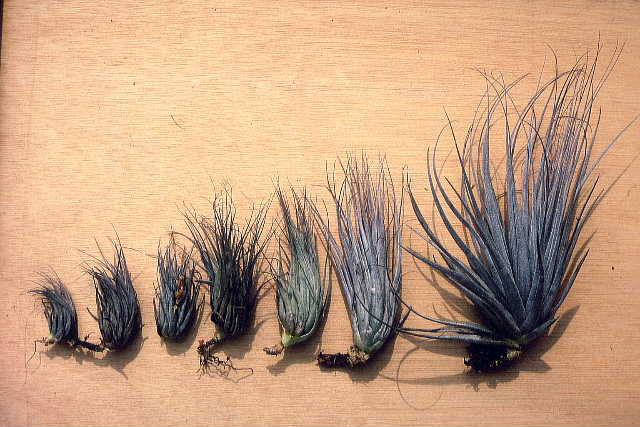
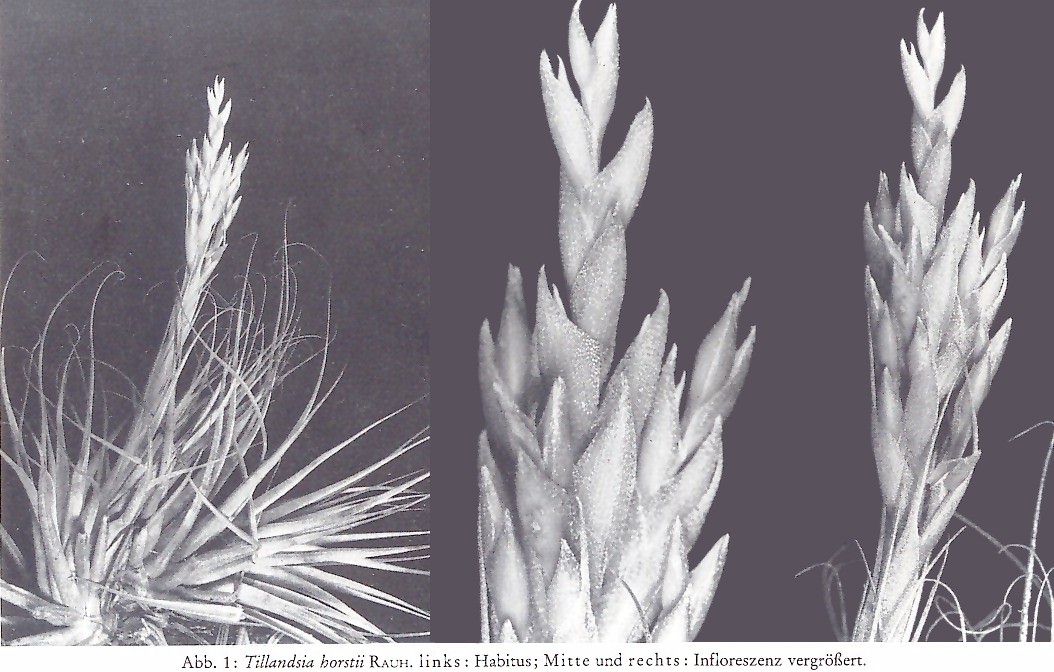
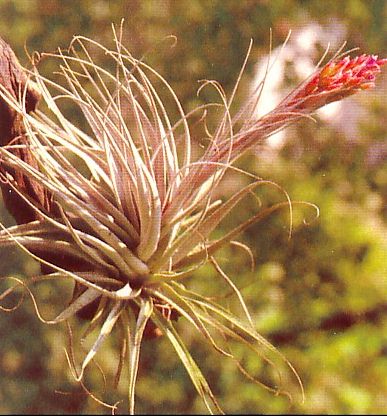
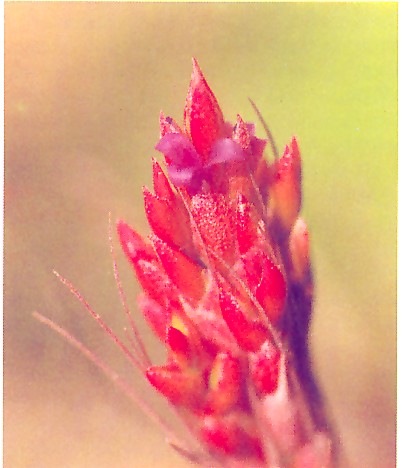
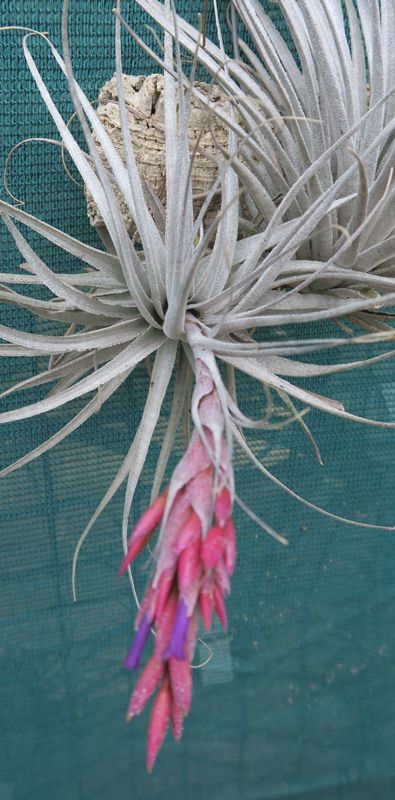
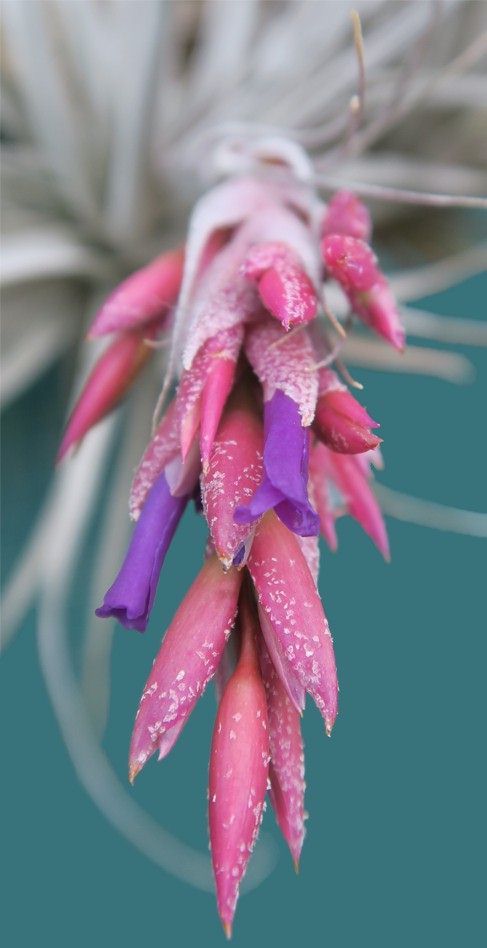
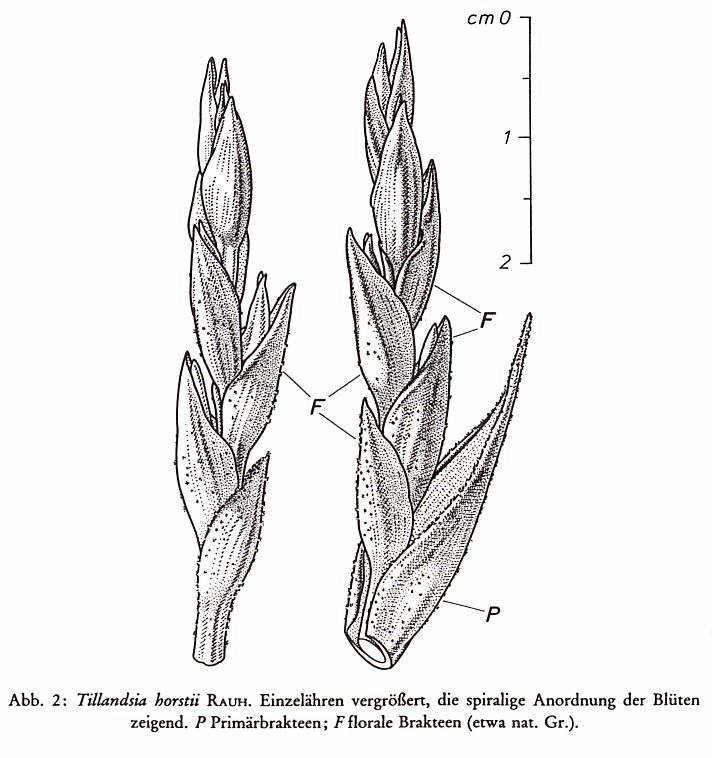
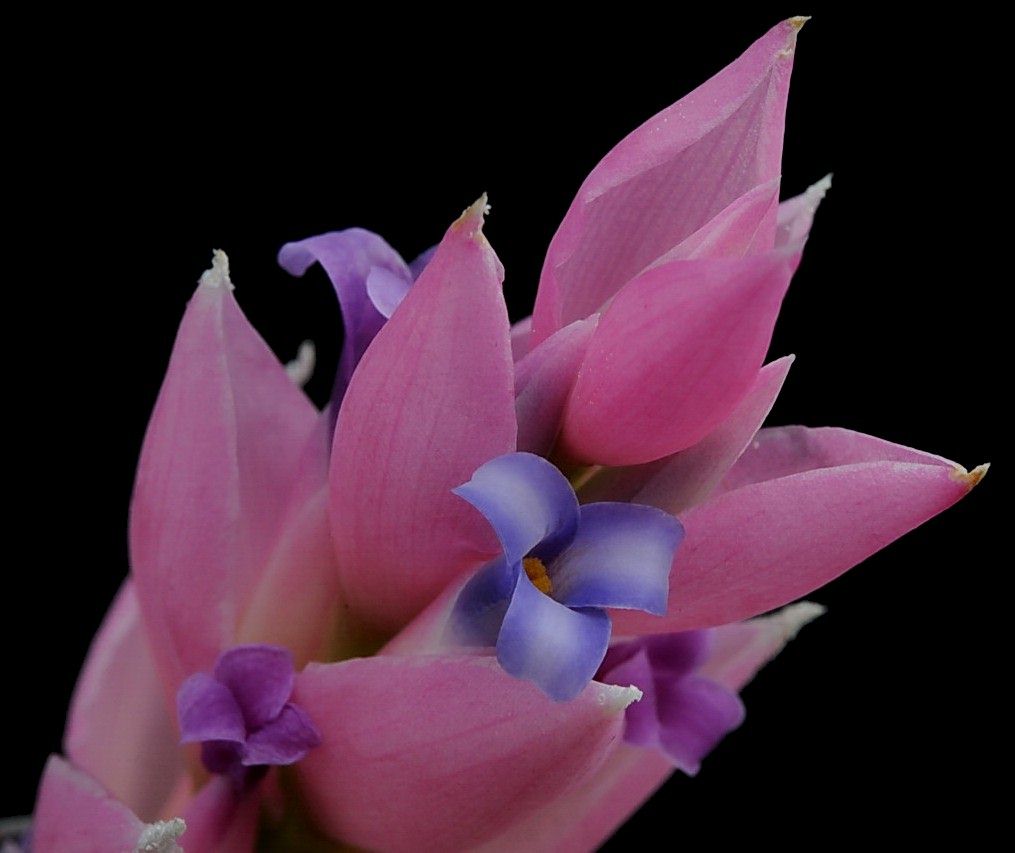
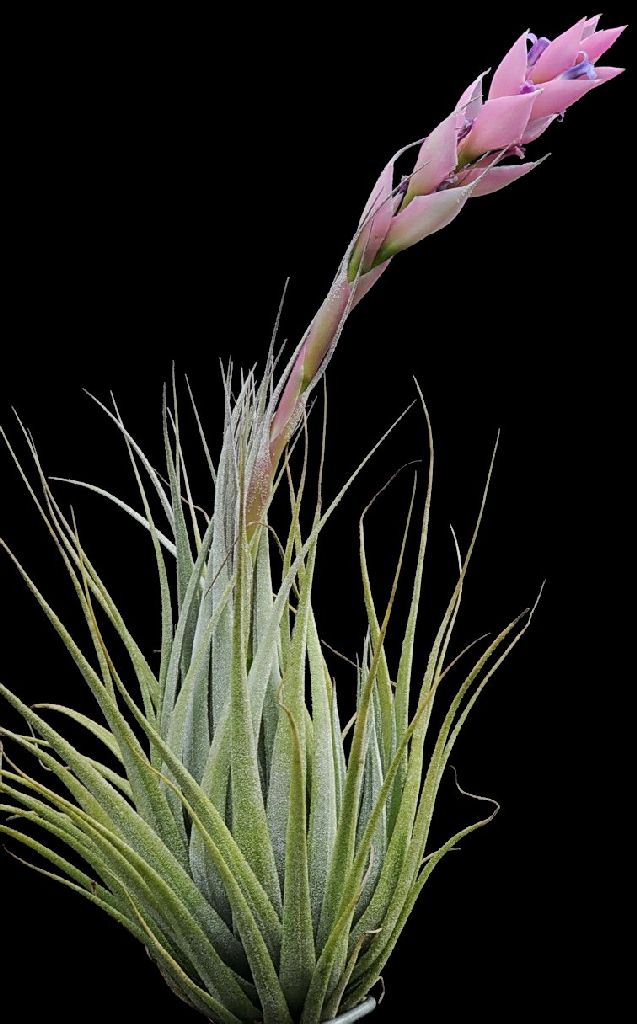
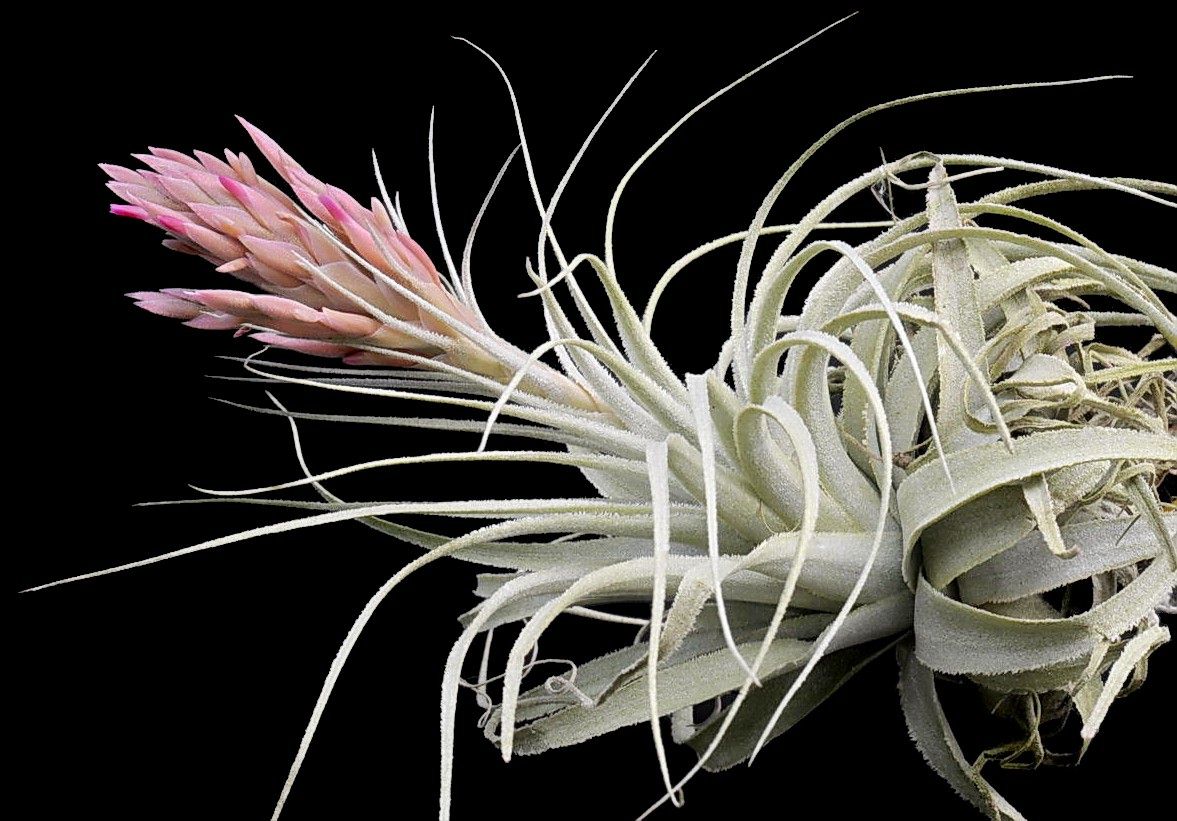
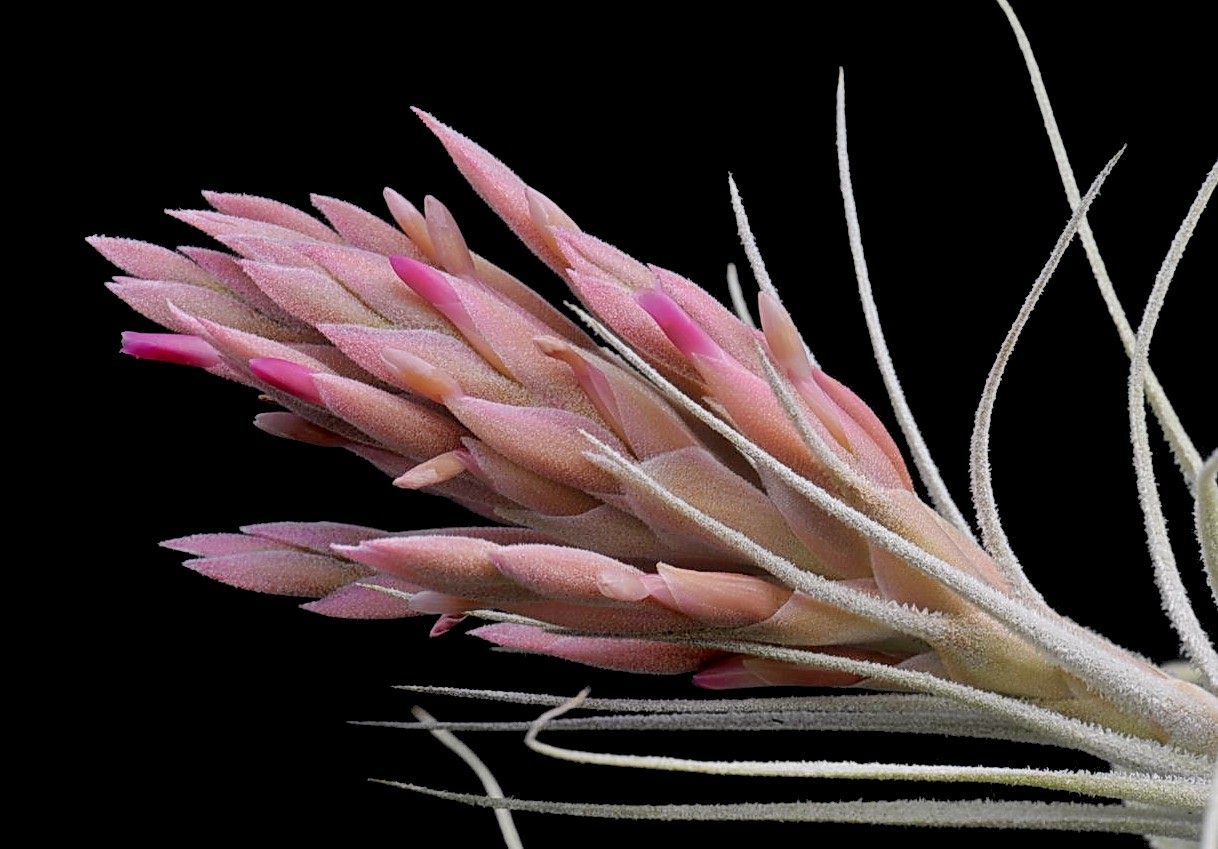
Bemerkungen zur Tillandsia horstii RAUH, 1979:
Summary translation by Derek Butcher:
Years ago Reinhard Thiken had found Till.horstii Rauh 1979 near Morro de Chapeu, Bahia. In 1990 the author Harro Heidt and his friend Thiken made a trip to Brasil again hoping to recollect this rare plant in the same area. Near a waterfall they found Till. stricta “piniformis” (in the trade), growing on steep rocks. After 3 days of field-work they only found few plants of Till. horstii and none of them had seeds. They only grew at places where Till. chapeuensis and Till. stricta were growing as well. Conclusion of the author: Till. horstii is a natural hybrid which shows intermediate characters of both parents.
Tillandsia horstii by Harro Heidt in Die Brom 2: 33-35. 1992
Translated by Derek Butcher
This rare plant was top on our wish list, as we were back in Brazil in 1990. After exactly 10 years, R. Thiken and I were back on tour. Mainly, we stopped in the South. Among other things, we were at the locality of Tillandsia meridionalis var. subsecundifolia. I must say unfortunately. In my report (Bromelie 2/89), I described a pasture, that you had to cross before you came to the site. A very large soybean field is now there. Obviously, everything is burned at the end of the harvest. We had to search for a long time until we found some plants. Fire, smoke and Tillandsias don't mix. Our aim was to collect plants. On the 10.3.1990 I met with my friend at the airport in Rio, after we had visited friends for a few days. After approx. 2 hours flight we arrived at Salvador de Bahia. We had luck and caught a bus just after, at 14.00 for Morro de Chapeu. At the almost new Hotel Diamantina, the best house in the place, we paid for a double room with breakfast at 22,-DM per day. Fortunately, we learned from the doorman, that you could rent a car in Morro de Chapeu. Again, we had luck and met a Brazilian cattleman the next morning at breakfast, who took us 20 km up to the Cachoeira (waterfall) on the Rio Doido. On this trip, I had the opportunity to see the countryside for the first time. When we drove past here earlier in the evening, it was already dark. It was a slightly hilly terrain and simply covered in grass. A low, thorn-bush was predominant. The road went straight over hill and dale. The air because of the high temperature, shimmered in the distance. If you saw cars, it was believed that they were hovering a few meters above the road. Above all arches a radiant blue sky without a single cloud. Around noon, the temperature was almost 50 ° C. For this reason we each consumed during our 5 hours in the terrain approx. 4 litres of water. Away from the road, the terrain consisted of large stone slabs.
They dropped from levels forming sides in the direction of the waterfall. The outer slabs were overhanging. They were about 250-300 m to the valley floor. The water of the small Rio Diodo was brownish dyed - like tea water. In a later search for I found that a small bog that went down to the river. The water was acidic and low in nutrients, because there are no fish other than a small kind of Tetra. Food for fish seems very scarce.
Where the wind had blown sand into the joints and holes of the rocks, cacti and other dry-resistant plants grow. Crouching in depressions was an Aechmea species. Every now and then a small, slightly striped columnar bromeliad grew. Due to its flowering habit, I thought Catopsis. It looked so similar to a Tillandsia paraensis with its slightly reddish leaves.
When I went to large boulders nearby, I suddenly faced flowering orchids. Cattleya elongata grew here in a 1 m˛ clump. Flowering plants were nearly 1 m high. Words are not possible to describe this magnificent sight to me. You simply must have seen something spectacular. As a Tillandsia fan I, who was not that interested in such a sight, was stunned by this plant beauty. The icing on the cake for the trip was finding a few minutes later a rock covered over and over with Tillandsia chapeuensis.
Just a few metres further on, on a slab of rock was Tillandsia stricta var. piniformis (Trade Name) growing in large groups. But where was the much desired, but rarely found Tillandsia horstii? We had come here only because of this plant which had caused us so much trouble. Only after quite some time, but in the immediate area close to the other two species, it grew on the extreme edge of a slab of rock. You should not get dizzy with this search operation, because otherwise it's virtually impossible to collect any of this "horstii". In my diary I've noted that: to collect is criminal. With roots firmly anchored into the cracks, I had to spend quite some force to draw it from the rock. Once, when I stood at the edge of the rocks, I saw a large group of white shimmering plants under me.I thought that I had discovered a large amount of Tillandsia horstii but a look through the binoculars - and it was "horstii" with the hope of many. There were only white shimmering Hechtias.
My next "horstii" grew like all others on the extreme edge of the Gorge. It was a great specimen, larger than all previously collected. I went, bent over, and tried to get rid of the plant from the rock. My backpack slipped over my shoulder and I lost balance and fell. During the free flight, I came by the Hechtias and wondered about the size of the plants. Shortly before I hit the bottom of the Gorge, I was awake.
I startled every time I fell asleep! The greatest happened then in the next few days. I could no longer stand on the edge of the ravine or run along it. The nightmare pursued me and influenced my actions. Three days we climbed through the tangle of rocks at the Chachoeiro de Rio Doido and found a total of only 15 plants. All other Tillandsias occurring there, grow more or less in large batches, only Tillandsia horstii is very rare. I will be explaining my thoughts later. All the plants arrived well at home. Some flowered already this summer.
Remarks on Tillandsia horstii RAUH, 1979:
In my report about this plant I mentioned it is rare at the site.
Already at the second day’s search I felt this situation as being odd. That's why I tried to look around to find out why this is so. As I investigated on the spot I noticed that this plant was only on rock formations, where Tillandsia chapeuensis grows together with Tillandsia stricta var. piniformis. Tillandsia horstii is not found on or directly from the rocks, where only one of these species grow. On 6 samples we found the almost dried-up inflorescence stand was still present. In all of these plants, the offsets were still hard to miss. No flowering inflorescence was found, only a single seed pod or whose remains.
If one assumes the larger the offset, when I look at Tillandsias from my collection, what had to be the seed pods, still exist in my opinion. As I already said, this was the case of a smaller single plant. As anyone who has ever collected Tillandsias in nature, will confirm, it happens even at the greatest rarities where there are 2 or 3 plants together. When sowing some seeds with the wing hairs probably clogged and together sprouted on the substrate. Once I found 4 Tillandsia horstii, however it was so that there were growing on a single old plant. This was evident when I had removed all dry leaves.
I think nature is not so wasteful and let 6 plants sprawling without having even forming a single seed capsule.
So what is left?:
I believe that Tillandsia horstii is a hybrid of nature and should be marked so. At home, I have examined my Tillandsia stricta var. piniformis (a Trade name is piniformis). Hardly one resembles the other. Finally, I could put together a number of examples, the Tillandsia horstii comes out last. For me in the future, I will mark this plant so: "Tillandsia x horstii RAUH"